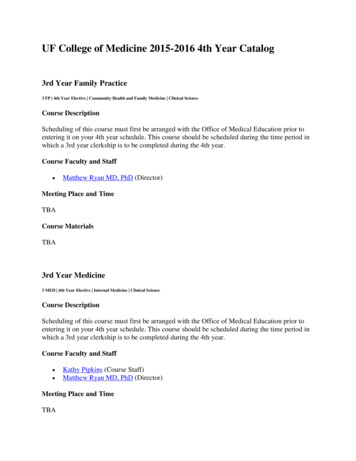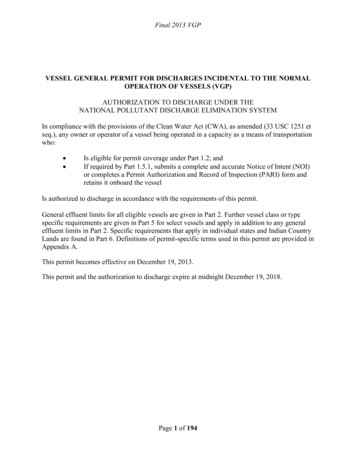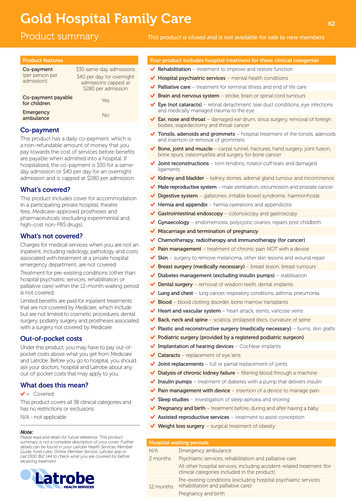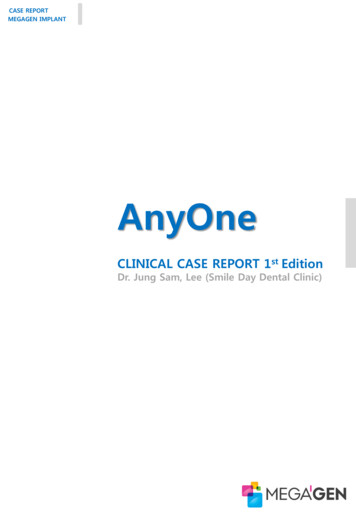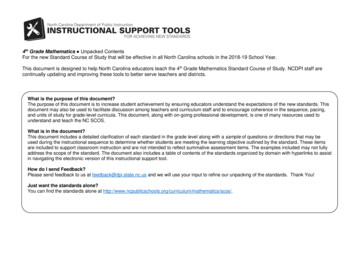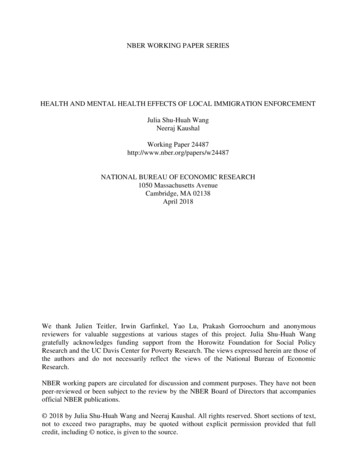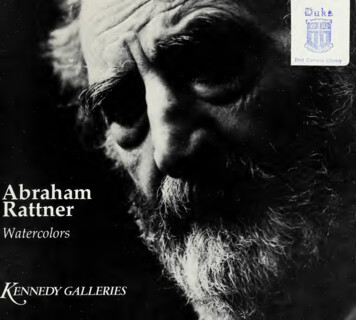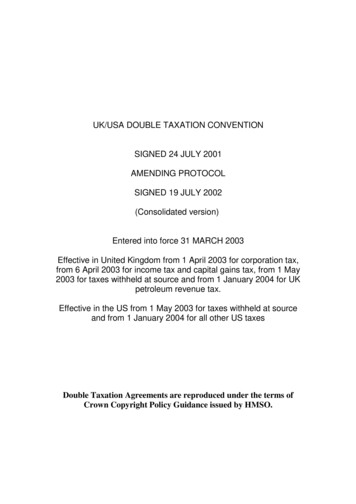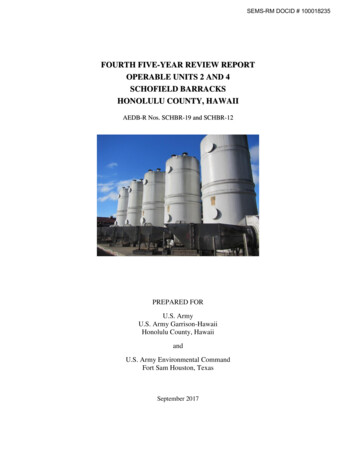
Transcription
SEMS-RM DOCID # 100018235REVIE\V REPORTFOURTH FIVE-YEAR REVIEWOPERABLE UNITSU1·1Ts 2 ANDA ·o 4SCHOFIELD BARRACKSHONOLULUHO oLUL COUNTY,COU TY, HAWAIIHA\\'AJIAEDB-RAl·DB-R Nos.:--:os. SCHBR-19SCIIBR-19 and SCHBR-12SCIIBR-12PREPARED FORU.S. ArmyU.S. Army Garrison-HawaiiHonolulu County, HawaiiandU.S. Army Environmental CommandFort Sam Houston, TexasSeptember 2017
FOURTH FIVE-YEAR REVIEW REPORTOPERABLE UNITS 2 AND 4SCHOFIELD BARRACKSHONOLULU COUNTY, HAW AllAEDB-R Nos. SCHBR-19 and SCHBR-12Approved by:DuteStephen E. DawsonColonel, U.S. AnnyCommanding
FOURTH FIVE-YEAR REVIEW REPORTOPERABLE UNITS 2 AND 4SCHOFIELD BARRACKSHONOLULU COUNTY, HAWAIIPrepared by:U.S. Army Corps of EngineersSeattle DistrictSeattle, Washington
Executive SummaryThe U.S. Army Garrison-Hawaii’s Schofield Barracks (Schofield Barracks; AEDB-R Nos. SCHBR-19and SCHBR-12) is located on Oahu, Hawaii, approximately 22 miles northwest of the City ofHonolulu. It is the Army’s largest installation outside the continental United States and home to theArmy’s 25th Infantry Division. The Schofield Barracks encompasses approximately 27.7 square miles.This is the fourth Five-Year Review (FYR) for two Operable Units (OUs) at Schofield Barracks: OU2, the groundwater, and OU 4, the former landfill. This FYR evaluates the protectiveness of theremedies implemented at those OUs. OU 1 and OU 3 achieved no further action during theirrespective remedial investigations, and thus do not require FYRs.The groundwater beneath Schofield Barracks (OU 2) is contaminated with trichloroethylene (TCE)and carbon tetrachloride. The remedy for OU 2 includes wellhead treatment for extracted groundwaterthat is used for drinking water, and long-term monitoring of the groundwater. Treatment is required tomeet the maximum contaminant level (MCL) for use in the drinking water system. The hydrogeologyon Oahu is very complex, which led the U.S. Environmental Protection Agency (EPA) to grant aTechnical Impracticability waiver for restoration of groundwater to the MCL. The results of the FYRshow that the remedy is functioning as intended and no changes have occurred to the site that mightcall into question the protectiveness of the remedy. The remedy for OU 2 is protective of human healthand the environment.The former landfill at Schofield Barracks (OU 4) was determined to be the source of carbontetrachloride contamination in the groundwater and one of several potential sources of TCEcontamination in the groundwater. The remedy for OU 4 included repairing the former landfill’s capand maintaining the cap and access restrictions. The results of the FYR show that the remedy isfunctioning as intended and no changes have occurred to the site that might call into question theprotectiveness of the remedy. The remedy for OU 4 is protective of human health and theenvironment.Fourth Five-Year Review Report, Schofield Barracks, OU 2 and OU 4i
Five-Year Review Summary FormSITE IDENTIFICATIONSite Name:Schofield BarracksEPA ID:HI7210090026AEDB-R Nos.: SCHBR-19 and SCHBR-12Region: 9State: HICity/County: Schofield Barracks, Honolulu CountySITE STATUSNPL Status: DeletedMultiple OUs?YesHas the site achieved construction completion?YesREVIEW STATUSLead agency: Other Federal AgencyIf “Other Federal Agency” was selected above, enter Agency name: U.S. Army GarrisonHawaiiAuthor name: Kayla PattenAuthor affiliation: U.S. Army Corps of Engineers, Seattle DistrictReview period: 1 June 2016 – 1 September 2017Date of site inspection: 18 January 2017Type of review: StatutoryReview number: 4Triggering action date: 10 September 2012Due date: 10 September 2017Fourth Five-Year Review Report, Schofield Barracks, OU 2 and OU 4ii
Five-Year Review Summary FormIssues/RecommendationsOU(s) without Issues/Recommendations Identified in the Five-Year Review:OU 2 and OU 4Protectiveness StatementsOperable Unit:2Protectiveness Determination:ProtectiveProtectiveness Statement:The remedy at OU 2 is protective of human health and the environment.Operable Unit:4Protectiveness Determination:ProtectiveProtectiveness Statement:The remedy at OU 4 is protective of human health and the environment.Sitewide Protectiveness StatementProtectiveness Determination:ProtectiveProtectiveness Statement:The remedies at the Schofield Barracks are protective of human health and the environment.Fourth Five-Year Review Report, Schofield Barracks, OU 2 and OU 4iii
Contents1.Introduction . 11.1.Purpose. 11.2.Authority . 12.Site Chronology . 23.Background . 34.3.1.Physical Characteristics . 43.2.Land and Resource Use . 53.3.History of Contamination. 83.4.Initial Response . 83.5.Basis for Taking Action . 93.5.1.OU 2 Groundwater. 93.5.2.OU 4 Landfill . 9Remedial Actions . 104.1.4.1.1.Remedial Action Objectives . 104.1.2.Remedy Description . 104.1.3.Remedy Implementation . 114.1.4.Systems Operations & Maintenance . 124.2.OU 4 Landfill . 134.2.1.Remedial Action Objectives . 134.2.2.Remedy Description . 134.2.3.Remedy Implementation . 144.2.4.Operations & Maintenance . 164.3.5.OU 2 Groundwater . 10NPL Status . 17Progress since the Last Five-Year Review . 175.1.OU 2 Groundwater . 175.1.1.Protectiveness Statement from Last Review . 175.1.2.Status of Recommendations and Follow-up Actions from Last Review . 175.2.OU 4 Landfill . 185.2.1.Protectiveness Statement from Last Review . 185.2.2.Status of Recommendations and Follow-up Actions from Last Review . 18Fourth Five-Year Review Report, Schofield Barracks, OU 2 and OU 4iv
6.Five-Year Review Process. 186.1.Administrative Components . 186.2.Community Involvement . 196.3.Document Review . 196.4.Site Inspection . 196.4.1.OU 2 Groundwater. 196.4.2.OU 4 Landfill . 196.5.6.5.1.OU 2 Groundwater. 206.5.2.OU 4 Landfill . 256.6.7.Data Review. 20Interviews . 25Technical Assessment . 257.1.Question A – Is the remedy functioning as intended by the decision documents? . 257.2. Question B - Are the exposure assumptions, toxicity data, cleanup levels, andremedial action objectives (RAOs) used at the time of the remedy selection still valid? . 267.3. Question C - Has any other information come to light that could call into questionthe protectiveness of the remedy?. 278.Issues . 289.Recommendations and Follow-up Actions . 2810.Protectiveness Statements. 2811.Next Review . 2912.References . 29Appendix AARAR Analysis . A-1Appendix BInterview Records . B-1Appendix COU 2 Site Inspection Report. C-1Appendix DOU 4 Site Inspection Report. D-1Appendix EGroundwater Data Mann-Kendall Trend Analysis Results . E-1Fourth Five-Year Review Report, Schofield Barracks, OU 2 and OU 4v
List of FiguresFigure 1. Location Map of Schofield Barracks. 4Figure 2. Site Location Map of OU 2 and OU 4. . 6Figure 3. Regional Groundwater Systems of Oahu, Hawaii . 7Figure 4. OU 4 Landfill Map . 15Figure 5. Location of Groundwater Monitoring Wells with TCE Concentrations and Plumes 24List of TablesTable 1. Chronology of Site Events . 2Table 2. OU 2 Groundwater Remediation Goals. 10Table 3. Status of Recommendations for OU 2 from the Last Five-Year Review . 17Table 4. Summary of Groundwater Sampling Results October 2010 to October 2015 . 22Table 5. Changes in Toxicity Values for OU 2 Groundwater . 27Fourth Five-Year Review Report, Schofield Barracks, OU 2 and OU 4vi
List of G-HIUSPACOMWTPμg/Lapplicable or relevant and appropriateair stripper treatment systemComprehensive Environmental Response, Compensation, and Liability ActCode of Federal Regulationscontaminant of concernDepartment of DefenseU.S. Environmental Protection AgencyFederal Facility Agreementfeasibility studyFive-Year Reviewinhalation unit risklong-term monitoringmaximum contaminant levelNational Contingency PlanNational Priorities Listoperations and maintenanceoperable unitremedial action objectiveremedial investigationreference concentrationreference doseRecord of DecisionSafe Drinking Water Actslope factortrichloroethylenetechnical impracticabilityUnited States Army Corps of EngineersU.S. Army Garrison-HawaiiUnited States Pacific Commandwater treatment plantmicrograms per literFourth Five-Year Review Report, Schofield Barracks, OU 2 and OU 4vii
This page intentionally left blankFourth Five-Year Review Report, Schofield Barracks, OU 2 and OU 4viii
1. IntroductionThe U.S. Army Garrison Hawaii’s (USAG-HI’s) Schofield Barracks (Schofield Barracks; EPA ID:HI7210090026) is an Army installation located on the island of Oahu, Hawaii. Four operable units(OUs) were established at the Schofield Barracks to address potential areas of contamination: OU 1 – Possible TCE SourcesOU 2 – Groundwater ContaminationOU 3 – Basewide Miscellaneous SitesOU 4 – Former LandfillThis Five-Year Review (FYR) addresses the remedial actions taken for OU 2 and OU 4 (AEDB-RNos. SCHBR-19 and SCHBR-12). As documented in the Records of Decisions (RODs) for OU 1 andOU 3, no remedial actions were required. Therefore, OU 1 and OU 3 are not included in this FYR.This is the fourth FYR for OUs 2 and 4. The triggering action1 for this FYR is the signing of theprevious FYR, which was on 10 September 2012. This FYR is due five years after the triggering dateon 10 September 2017.1.1. PurposeThe purpose of a FYR is to determine whether the remedy at a site is protective of human health andthe environment. The methods, findings, and conclusions of reviews are documented in FYR reports.In addition, FYR reports identify issues found during the review, if any, and provide recommendationsto address them.1.2. AuthorityThe USAG-HI is preparing this FYR pursuant to the Comprehensive Environmental Response,Compensation, and Liability Act (CERCLA) §121 and the National Contingency Plan (NCP).CERCLA §121 states:If the President selects a remedial action that results in any hazardous substances,pollutants, or contaminants remaining at the site, the President shall review suchremedial action no less often than each five years after the initiation of such remedialaction to assure that human health and the environment are being protected by theremedial action being implemented. In addition, if upon such review it is the judgmentof the President that action is appropriate at such site in accordance with section [104]or [106], the President shall take or require such action. The President shall report tothe Congress a list of facilities for which such review is required, the results of all such1The triggering action is the activity that initiates the five year review process. Initial Five-Year Review reportsare triggered by one of several activities, such as signature of a decision document or construction of the remedy.Subsequent Five-Year Reviews are typically triggered by the signature of the previous Five-Year Review report.(EPA, 2001)Fourth Five-Year Review Report, Schofield Barracks, OU 2 and OU 41
reviews, and any actions taken as a result of such reviews.The NCP, at 40 CFR §300.430(f)(4)(ii), further states:If a remedial action is selected that results in hazardous substances, pollutants, orcontaminants remaining at the site above levels that allow for unlimited use andunrestricted exposure, the lead agency shall review such action no less often than everyfive years after the initiation of the selected remedial action.After Schofield Barracks was placed on the National Priorities List (NPL), a federal facility agreement(FFA) was negotiated with the U.S. Environmental Protection Agency (EPA), the State of Hawaii, andUSAG-HI under CERCLA, Section 120. The FFA was signed by USAG-HI on 23 September 1991,by EPA on 27 September 1991, and by the State of Hawaii Department of Health on 5 June 1996. TheFFA identified Schofield Barracks as being under the jurisdiction, custody, or control of the U.S.Department of Defense (DoD) and subject to the Defense Environmental Restoration Program.The U.S. Army Corps of Engineers (USACE) has conducted this fourth FYR of the remedial actionsimplemented at OUs 2 and 4 at the Schofield Barracks. This review was conducted from June 2016through September 2017. This report documents the results of the review.2. Site ChronologyA chronology of significant activities associated with OUs 2 and 4 is listed in Table 1.Table 1. Chronology of Site EventsEventDateLandfill used as open burn dump1942 to 1967Landfill converted to sanitary landfill1967Landfill operations ceased1981Landfill closed1983TCE detected in Schofield Barracks supply wellsApril 1985Schofield Barracks temporarily switched to city and county water suppliesMay 1985Air stripping treatment unit installed at the water treatment plant (WTP) to treat water fromSchofield supply wellsSeptember 1986Schofield Barracks was placed on the NPLAugust 1990A Federal Facility Agreement (FFA) was negotiated with the EPA, the State of Hawaii, andUSAG-HISeptember 1991Preliminary Assessment/Site Investigation for OUs 2 and 4 was completedMay 1992A Community Relations Plan for Schofield Barracks was completedJune 1992Remedial Investigation/Feasibility Study (RI/FS) for OU 4 was completedDecember 1995RI/FS for OU 2 was completedFebruary 1996Record of Decision (ROD) for OU 4 completedSeptember 1996Fourth Five-Year Review Report, Schofield Barracks, OU 2 and OU 42
EventDateROD for OU 2 completedFebruary 1997OU 2 Long-Term Monitoring Program implementedApril 1997OU 4 Long-Term Monitoring Program implementedJune 1998OU 4 remedial action completedJuly 1998Schofield Barracks removed from the NPLAugust 2000First FYR completedSeptember 2002Sampling frequency of various OU 2 and OU 4 wells decreasesOctober 2002TCE and PCE detected at Sandwich Isles Communication exploratory wells2005Sampling frequency of various OU 2 and OU 4 wells decreasesDecember 2005EPA approves of Addenda to Final Operations and Maintenance (O&M) and Long TermGroundwater Monitoring Plans for OU 2 and OU 4July 2006Second FYR completedSeptember 2007Sandwich Isles air stripper treatment system (ASTS) installedSeptember 2011Third FYR completedSeptember 2012Sandwich Isles ASTS decommissioned due to lack of need for treated water20143. BackgroundSchofield Barracks is located on the Schofield Plateau between the Waianae and Koolau MountainRanges in central Oahu (Figure 1). It is the Army’s largest installation outside the continental UnitedStates. It currently serves primarily as the home of the 25th Infantry Division, whose mission is to beprepared for deployment to a theater of operations to perform combat operations as part of a corpscounterattack. It conducts theater-wide deployment within 54 hours of notification to perform combatoperations in support of the United States Pacific Command (USPACOM) theater strategy. In supportof this mission, the Division’s main activity is training. Installation facilities include a medical facility,community and housing support facilities, and transportation and repair facilities.Fourth Five-Year Review Report, Schofield Barracks, OU 2 and OU 43
Figure 1. Location Map of Schofield BarracksFigure Source: AEC and DPW, 20123.1. Physical CharacteristicsSchofield Barracks is located approximately 22 miles northwest of the City of Honolulu. The closestmunicipality is Wahiawa, which is immediately north of the Schofield Barracks. The installationencompasses approximately 27.7 square miles, and is divided into three sections: the East Range, theMain Post or Barracks in the west, and the South Range Acquisition Area.OU 2 consists of the groundwater beneath Schofield Barracks, which is contaminated withtrichloroethylene (TCE) and carbon tetrachloride. The groundwater is 550 to 650 feet below groundsurface and is part of the groundwater body underlying the Schofield Plateau known as the SchofieldHigh-Level Water Body (Figure 3).OU 4 (Figure 2) consists of a former landfill located in the northwestern section of Schofield Barracks.OU 4 was identified as the source of carbon tetrachloride to the groundwater (OU 2); however, asource for the TCE was not identified (HLA, 1996b).The water table (potentiometric surface) elevation of the Schofield High-Level Water Body isapproximately 275 feet above mean sea level. This elevation is lower than the adjacent dikeimpounded water bodies to the east (Koolau Mountain Range) and west (Waianae Mountain Range)and higher than the basal water bodies to the north (Waialua Basal Water Body) and south (HonoluluPearl Harbor Basal Water Body) that have elevations of less than 50 feet above mean sea level.Fourth Five-Year Review Report, Schofield Barracks, OU 2 and OU 44
The northern and southern boundaries of the Schofield High-Level Water Body (characterized asgroundwater dams) have been inferred from water-level measurements in domestic and irrigationwells on either side of the groundwater dams and by geophysical surveys. The groundwater damsimpede groundwater flow to the Honolulu-Pearl Harbor and Waialua Basal Water Bodies. However,the nature and locations of these water body boundaries are not precisely known.The climate at Schofield Barracks is characterized by moderate temperatures that remain relativelyconstant throughout the year. The average annual rainfall in the vicinity of Schofield Barracks isapproximately 1.2 meters, more than half of which occurs during the rainy season from Novemberthrough February (HCS, 2009).3.2. Land and Resource UseSchofield Barracks was originally established in 1908 as a base for the Army’s mobile defense ofPearl Harbor and the Island of Oahu. It served as a major support facility during World War II,temporarily housing more than one million troops. It also served as a support and training facilityduring the Korean and Vietnam wars. Since the Vietnam War, it has served primarily as a trainingfacility.The installation is divided into three sections: the Schofield Barracks Main Post, the SchofieldBarracks East Range, and the South Range Acquisition Area. The towns of Wahiawa and Mililani,other military properties, and private properties are adjacent to Schofield Barracks. Some of theprivate properties are used for agricultural purposes such as growing sugar cane and pineapples.Groundwater is the principal source of drinking water for the population of Oahu and is the source offresh water for other uses such as agriculture. Most of the groundwater wells in the Schofield Barracksarea are used as municipal water supplies or have irrigation uses.Fourth Five-Year Review Report, Schofield Barracks, OU 2 and OU 45
Operable Unit 4Former LandfillFigure 2. Site Location Map of OU 2 and OU 4.Note: OU 2 (groundwater) does not have a defined boundary. OU 2 is the groundwater in this general location.Figure adapted from: AEC and DPW, 2012Fourth Five-Year Review Report, Schofield Barracks, OU 2 and OU 46
Figure 3. Regional Groundwater Systems of Oahu, HawaiiFigure source: AEC and DPW, 2012Fourth Five-Year Review Report, Schofield Barracks, OU 2 and OU 47
3.3. History of ContaminationThe former landfill (OU 4) was an open burn dump from approximately 1942 until 1967, when it wasconverted to a sanitary landfill in response to provisions of the Clean Air Act (Ecology andEnvironment, Inc., 1981; Kennedy Engineers, 1980). The former landfill was used to dispose of awide variety of solid wastes from various military installations, of which the major contributors wereSchofield Barracks, Wheeler Air Force Base (currently Wheeler Army Airfield), and the WahiawaRadio Station (U.S. Army Support Command, Hawaii, 1983; Kennedy Engineers, 1980). Most of thewaste deposited in the landfill was domestic refuse from the surrounding base housing (Ecology andEnvironment, Inc., 1981); however, wastes were also disposed from various industrial operations (e.g.,vehicle and equipment maintenance and construction). Tripler Army Medical Center reportedlycontributed medical wastes including pathogenic, infectious, and pharmaceutical (expired andunusable drugs) wastes.Other materials reportedly disposed in the former landfill were organic solvents, sewage sludge,asbestos, pesticide containers, unusable paints, metallic debris, vegetation, and tree stumps(Environmental Science and Engineering, 1984). Hazardous materials, including live munitions, acids,and solvents, were also reported to have been dumped in the landfill. No records were availableconcerning the types, amounts, or volumes of wastes disposed at the former landfill, but the rate hasbeen estimated at 100 tons per day. (Kennedy Engineers, 1980)In April 1985, TCE was detected in groundwater from the Schofield Barracks water-supply wells. Thesource of the TCE contamination could not be identified; however, it was assumed that TCE likelyoriginally migrated from one or more surface locations through the soil and bedrock to the underlyinggroundwater.3.4. Initial ResponseLandfill operations ceased on December 31, 1981, prior to the discovery of TCE in the water supplywells. Closure was completed by the end of 1983. The landfill surface was graded and covered with alayer of compacted soil, but the closure plan did not include installation of monitoring wells or aleachate collection system. The landfill was to be periodically monitored and inspected for anydeficiencies, and corrective actions were to be initiated if necessary. However, by 1996 (the time ofsigning of the OU 4 ROD), there were no records of monitoring and inspections, and landfillsubsidence had resulted in numerous cracks and the deterioration of the landfill cap.In May 1985, one month after the detection of TCE in the water supply wells, Schofield Barracksissued a press release regarding the detection of TCE and the temporary switch to city and countywater supplies. In September 1986, USAG-HI installed an air stripping treatment unit (the SchofieldBarracks water treatment plant [WTP]) to remove TCE and carbon tetrachloride. In 1987, EPAestablished a maximum contaminant level (MCL) for TCE of 5 micrograms per liter (μg/L) in drinkingwater. As a result of the detection of TCE in the water supply wells, the Schofield Barracks was placedon the NPL in August 1990.Fourth Five-Year Review Report, Schofield Barracks, OU 2 and OU 48
3.5. Basis for Taking Action3.5.1.OU 2 GroundwaterDuring the remedial investigation/feasibility study (RI/FS) for OU 2, groundwater at the SchofieldBarracks was determined to be contaminated with TCE and carbon tetrachloride. Antimony andmanganese were also detected at levels above their respective MCLs, but because these detectionswere inconsistent, they were not retained as contaminants of concern (COCs). Carbon tetrachloride,antimony, and manganese detections were limited to groundwater below the former landfill area, whileTCE was detected below the former landfill and beneath the East Range and Wheeler Army Airfieldarea (see Figure 2).Carbon tetrachloride contamination in groundwater is generally limited to the area beneath the landfill,which is considered the likely source. TCE contamination is generally located in the central andwestern portions of the Schofield Barracks (near supply wells and the landfill). TCE was also foundsouth of the Schofield Barracks, which likely resulted from migration from the primary contaminationbeneath the Barracks. Figure 5 shows the approximate location of the TCE plumes and theconcentration of TCE from the 2014 and 2015 sampling event. The plume location is generalized dueto the complex hydrogeologic conditions.The risk assessment for OU 2 evaluated domestic use of the untreated groundwater water by adultsand children. The non-cancer hazard indices for both children and adults exceeded EPA’s benchmarkhazard index2 of 1.0; however, most of this risk was due to the inconsistent detections of antimonynear the former landfill. Because of the inconsistencies, and the fact that exposure to groundwaterfrom this area is limited, the elevated hazard indices were not considered significant. All of thecarcinogenic risks were below or within EPA’s acceptable risk range of 10-6 to 10-4. No ecologicalrisk, including from potential irrigation use of the groundwater, was found.Although the OU 2 ROD does not explicitly describe the basis for taking action, the ROD makes clearthat the actual or threatened releases of hazardous substances from the site, as reflected inconcentrations of TCE and carbon tetrachloride above their respective MCLs, presented an imminentand substantial endangerment to public health, welfare, and the environment.3.5.2.OU 4 LandfillDuring the RI/FS for OU 4, it was determined that soil gas, subsurface soil, and groundwater had beenimpacted by the former landfill, primarily by volatile organic compounds, including TCE. The riskassessment identified thre
SCHOFIELD BARRACKS . HONOLULU COUNTY, HAWAII . AEDB-R Nos. SCHBR-19 and SCHBR-12 . PREPARED FOR . U.S. Army . U.S. Army Garrison-Hawaii . Honolulu County, Hawaii . and . U.S. Army Environmental Command . Fort Sam Houston, Texas . September 2017 . FOURTH FIVE-YEAR REVIE\V REPORT OPERABLE U1 ·A 1Ts 2 ·o 4 SCHOFIELD BARRACKS HO oLUL COU TY .
